If you’re planning your first trip to Italy, it’s essential to have some key information and tips to ensure a smooth and enjoyable experience. In this guide, I provide all the vital details you’ll need to know about visiting Italy, as well as advice on what mistakes to avoid.
In addition, I’ll give you insights into where you should consider making advance reservations, booking tours, and purchasing passes to make the most of your trip.
So, whether you’re eager to explore Italian history, savor delicious cuisine, or simply soak up the stunning scenery, this guide will help you make the most of your Italian adventure!
40 Essential Tips For Visiting Italy
1. Know a Little Italian
One of the best tips for visiting Italy is to learn some basic words and phrases before you trip.
English is fairly widely spoken. But you’ll get off on a better foot and earn respect if you use a few common phrases.
- Please — Porta favore
- Thank you — Grazie
- One espresso — un (OON) espresso
- Hi/bye (informal) — Ciao
- Good Morning — Buongiorno
- Good evening — Buon sera
2. Learn More Italian
If you have time before your trip, learn a little more Italian. It will likely enhance your visit and (perhaps more importantly) help you read menus.
I use Duolingo to pick up some Italian or French. Download the app on your phone. You can practice in tiny manageable chunks. It will help you read menus, signs, and historic plaques.
3. When To Go To Italy
The best time to visit is shoulder season, spring or fall. May, September, and October are the best months weather wise.
I can say from experience that summer is dreadful and best avoided, unless you’re headed to northern Italy (but not Venice). In the summer, Italy’s extremely hot and extremely overrun with tourists.
I’ve recently visited Italy in late February. Aside from a few rain drops, it was pretty darn pleasant and I had museums and the main attractions in Rome mostly to myself. (Well, not the Sistine Chapel).
4. Most Italian Cities are Perfectly Walkable
Walking is decidedly my favorite way to get around when I travel. I’ll only deviate from this approach if I’m somewhere very large, like Paris.
In Italy, you can walk basically everywhere. Even in Rome, I never used the metro and only took a cab once.
Walking is also the best way to explore Italy’s small cities and towns. You see more that way and can get happily lost meandering through atmospheric cobbled lanes. Though, when visiting hill towns, be prepared for some vertical hikes.
5. Buses in Italy
If you’re taking the bus in Italy, be forewarned. You’ll need to validate your ticket or risk a fine.
You should pre-purchase a ticket at an electronic machine at the bus station or a “Tabacchi” shop. Don’t rely on being able to buy a ticket once you’re on the bus. The machines might not work.
6. Taking Trains In Italy
Trains are an efficient way to get around Italy. You likely won’t need a rail pass.
Most train travelers in Italy take relatively short rides on the Milan–Venice–Florence–Rome circuit. For these trips, it’s cheaper to buy point-to-point train tickets than a rail pass.
You can buy tickets online here or at the ticket machines at the train stations.
If you use a ticket window instead, be sure to get in the right (and likely slow moving) line.
When you buy a train ticket in Italy, it doesn’t have a time or date on it. Before you board a train, you need to validate your ticket on the machine. The yellow validation machines are usually on the train platforms.
A conductor won’t validate your ticket once you’re aboard. And you can’t buy your ticket on the train either.
Claiming you forgot isn’t a sufficient excuse to avoid a fine. And the fine will be steep — €50 if you pay immediately on the train or up to €200 if you pay late.r
Train travel isn’t like air travel. You don’t need to be there well in advance of departure, if you’ve already purchased your tickets and reserved your seat.
The train won’t be listed on the master departure board until about 20 minutes before it leaves.
7. Renting A Car In Italy
I am a huge fan of road trips by car. It gives you so much more freedom than a bus or tour would. And you don’t have to stick to an inflexible schedule.
Plus, renting a car lets you explore off the beaten track destinations or under the radar villages that aren’t accessible by public transportation.
The small towns aren’t car friendly though. So you’ll want to park outside the town center or in a lot at the town entrance.
I usually use AutoEurope to rent cars. Make sure you rent a small or compact car.
It’ll help when you’re trying to squeeze through medieval lanes or into tight parking spots. If you can drive a manual stick shift, you’ll find that rentals are much cheaper than automatics.
One car rental tip for Italy that you need to know — learn how your car goes into reverse before you leave the rental car lot. It’s always different.
Once, I had to google YouTube videos to figure out how to put X brand of car in reverse.
You won’t want to have a car in cities Rome, Venice, or Florence though. So if you’re starting your trip in one of these cities, pick up the car when you leave.
Here’s my complete guide to renting a car and driving in Europe.
8. Toll Roads
The autostradas are Italy’s toll roads.
Be sure to have cash for tolls or, when renting a car, ask for a telepass to whiz through toll booths. An automatic telepass will definitely save you time.
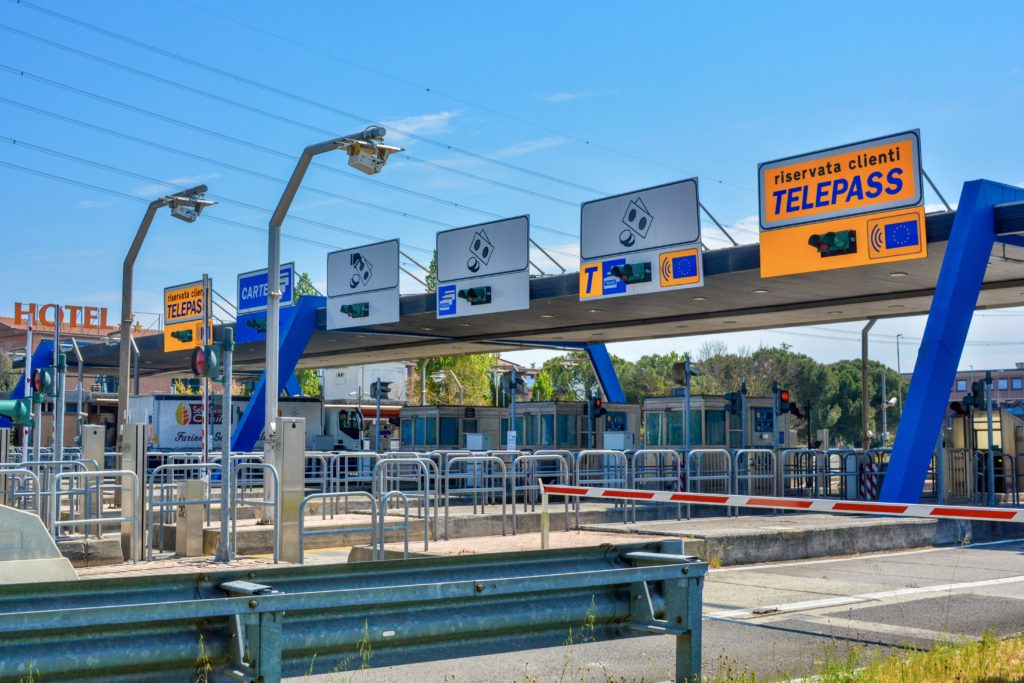
If you have cash, enter a “Biglietto” lane with a green light. Take the ticket. When you exit the autostrada, you’ll go through another toll booth like the one shown above.
Insert your ticket and then insert your payment. You can pay with cash or credit cards. Lanes aired “carte” are just for credit cards. Lanes marked with bills and coins are for cash payment.
9. Parking In Italy
Sometimes something as simple as parking can be a hassle in Italy. When you’re visiting Italy’s towns, especially the hill towns, you will want to park outside the city center. They’re often by the town’s main gates.
The parking lots are called “parcheggios.” Park in an outdoor lot, not an indoor lot, if you can. The indoor lots can have steep entry and exits and tiny spaces.
Usually parking is on a “pay and display” basis. There will be a kiosk where you can a ticket and indicate how long you will park and paying. Display that ticket in your car window while you are sightseeing.
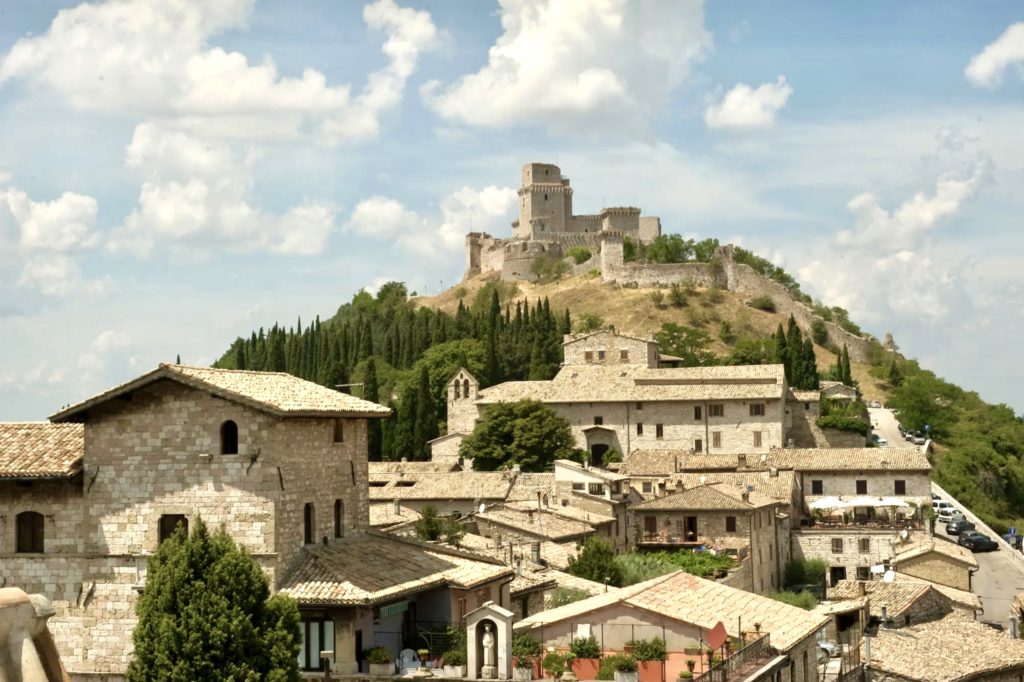
Other times, you will get a ticket as you enter the lot. You pay the ticket when you get back to the lot. Then, put the ticket in the slot to exit.
If there are several parking lots for the town, be sure to make a note of which one you parked in or drop a pin to get back.
10. GPS In Italy
I’ve found that the GPS works fairly well in Italy. You can rent one when you pick up your car. Or, you can bring your own from home.
I usually use my iPhone or iPad and bring a car charger. Sometimes you can hook up your device to the touchscreen monitor in your rental car.
You GPS will also tell you when mobile speed cameras are approaching.
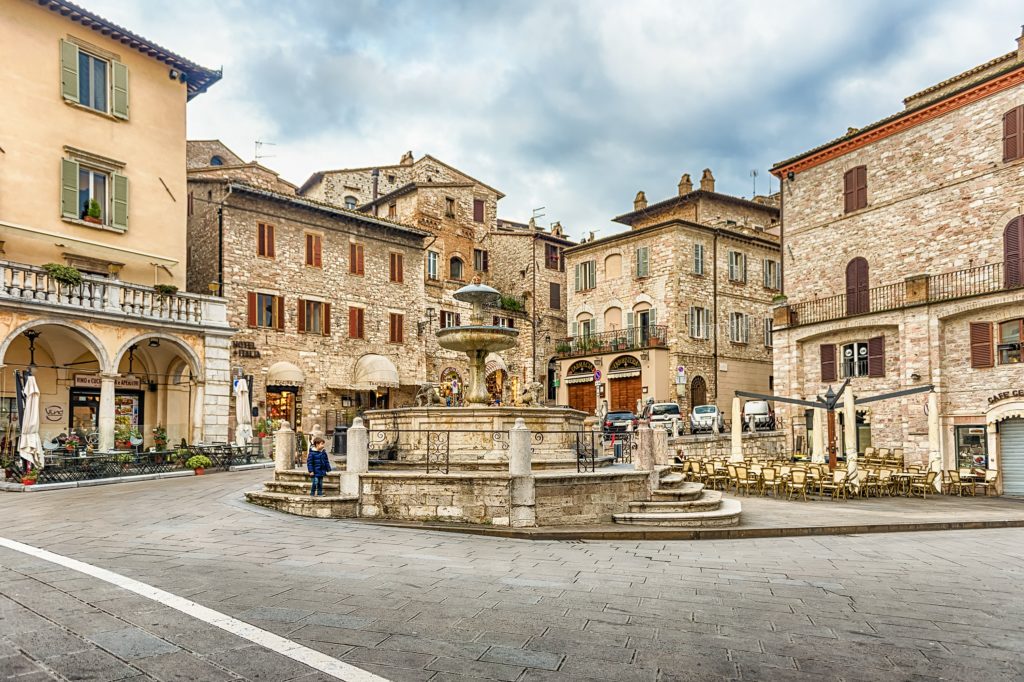
But it will not tell you if you’re approaching a driving zone that is restricted to residents. You don’t want to inadvertently venture into these areas or you could be slapped with a big fine.
I noticed that, when walking, my GPS will tell me I’ve “arrived” a little bit before the actual destination.
11. Wifi In Italy
You’ll likely have decent wifi at any hotel or Air Bnb you stay at. There are a few free wifi hotspots.
But generally the public wifi is iffy or non-existant.
If you want phone service to use your apps or search google, you should either buy a sim card on arrival or arrange service in advance with your cellular service.
12. Carry Cash
Credit cards are widely accepted at hotels, restaurants, and tourist attractions. But not everyone takes credit cards, especially for small purchases like a coffee or souvenir.
Carry cash at all times. That is, if you want a gelato. You may need it for the loo as well, which typically costs .50 euros.
Try to carry small bills. No one wants to make change for a 100 euro note.
13. Where To Stay in Italy?
Italy has plenty of beautiful 5 star hotels. Be prepared for much smaller rooms than in U.S. cities. The only hotels with decent size rooms are in the countryside.
You may prefer to stay in an apartment or Air Bnb.
When you’re doing urban sightseeing, it pretty much eats up the day. You may not have time to enjoy the facilities of a fancy hotel.
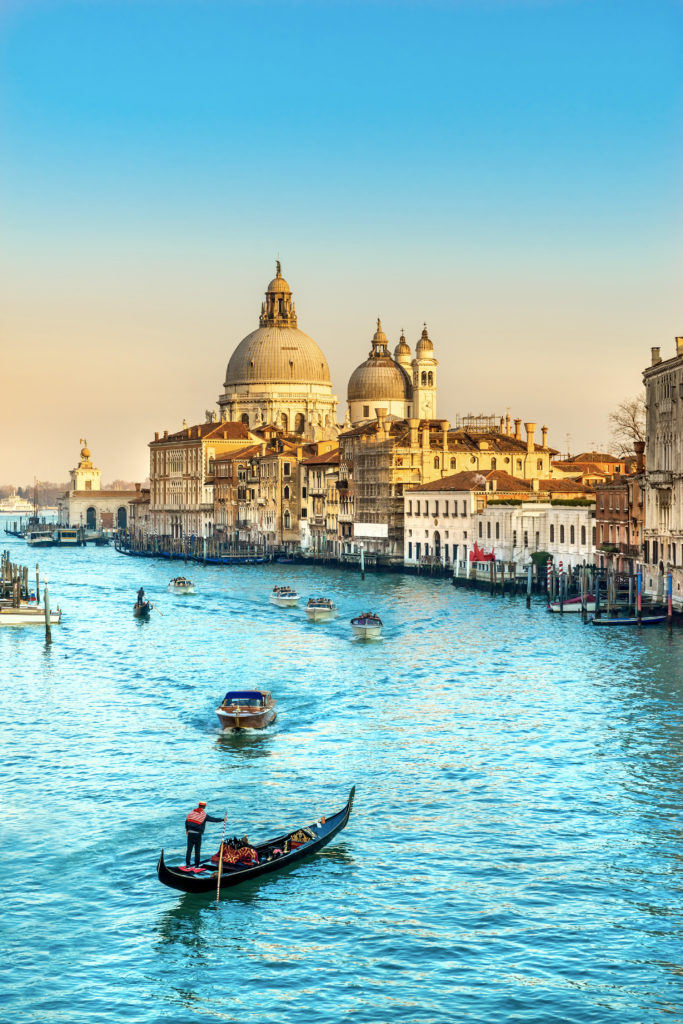
14. How Long To Stay in Venice?
Historic Venice is an overwhelming beautiful city. But you may be wondering how many days to stay in Venice.
If you don’t like crowds, you should just plan one day in Venice and base somewhere else, like Verona. Unless you’re there off season, when the crowds ebb.
Last time I was in Venice, I stayed 7 days, I preferred it over my other slap dash visits. There’s so much to do in Venice that the city merits a few days.
Also, like most popular tourist sites, it’s best to avoid Venice in the summer. And unless you have deep pockets, might skip the extremely expensive gondola ride.
15. Should You Take A Gondola Ride?
Wondering if you should take a gondola ride in Venice and if it’s really worth it? Well, it’s certainly a touristy activity, but then again, Venice is known for its appeal to tourists.
From my personal experience, a gondola ride, especially at night, can be incredibly romantic. It offers a unique perspective on the city, allowing you to see Venice from its famous waterways, unobstructed by crowds.
It’s a quintessential Italian bucket list experience that lets you appreciate the city’s charm in a whole new way.
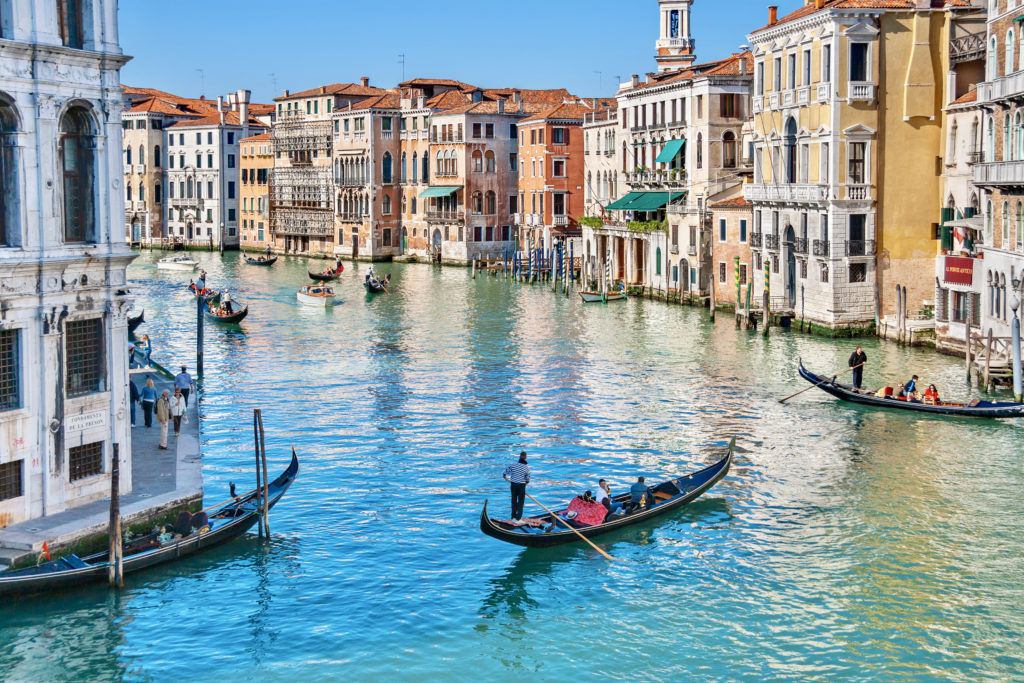
I’ve also been to Venice and skipped the gondola ride. While undeniably a unique experience, gondolas are very expensive.
The rates are 80 euros if you book it before sunset or 100 euro if you want it after and during sunset. The rate is per boat, not per passenger.
Here are some of the sample gondola rides you can go on:
- shared gondola ride across the Grand Canal
- shared 2 hour gondola ride past main sites
- 30 minute private gondola ride
- 45 minute private gondola ride
- small group walking tour and gondola ride
- 30 minute private gondola ride at night
- 2.5 hour private city tour + gondola ride
16. How Long To Stay in Rome?
I can’t overemphasize how much there is to do in Rome!
Rome is overflowing with archaeological sites, must see landmarks, exquisite churches, and art at every turn both inside and outside. I was recently there for a full week and still felt like I missed too much.
If you really want to see Rome’s hidden gems and newly opened archaeological sites, you need more than 1-2 hectic days dashing through the Colosseum, Roman Forum, and the Vatican Museums.
But if you have plans to road trip in Tuscany or Umbria, a few days may be all you have. If so, check out my guide to how many days to stay in Rome, with sample itineraries.
17. Vatican City
The Vatican City can be overwhelming. You’ll definitely need some tips before visiting.
There’s a lot to see inside the Vatican: the sculpture museums, the Vatican Pinacoteca (painting gallery), Raphael Rooms, Borgia Apartments, maps and tapestries, and the Michelangelo frescos in the Sistine Chapel.
You should buy a skip the line ticket in advance from a reseller. If you don’t splurge for skip the line access, you could wait hours in line to get inside. There are even waits in low season.
Click here to book a Vatican ticket with Get Your Guide. Click here to purchase a Vatican ticket with Viator.
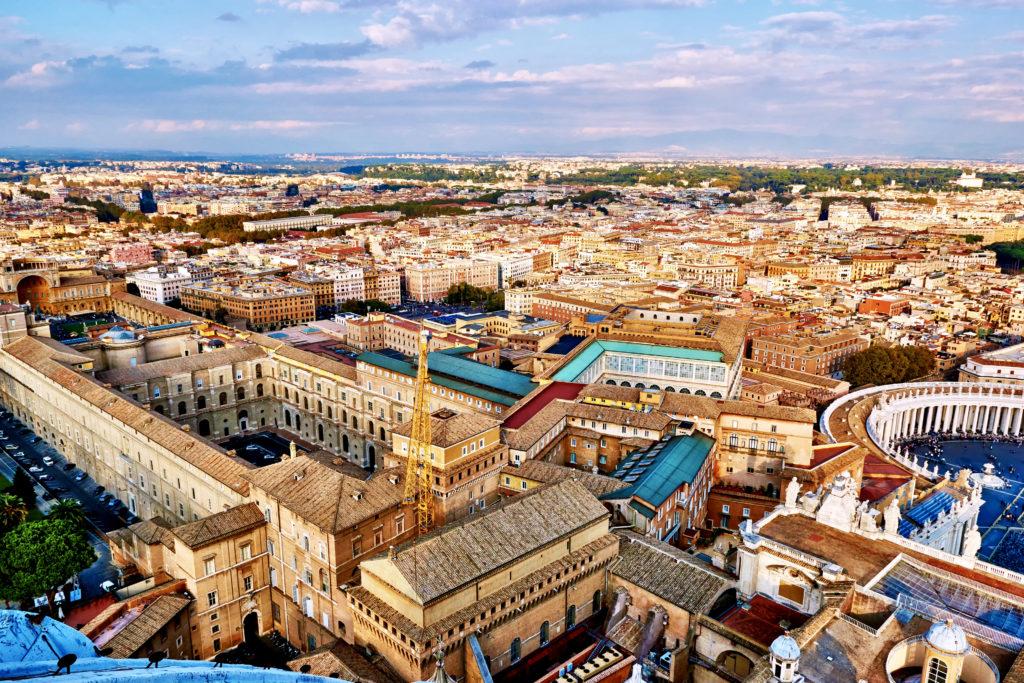
Or, you can pick a guided tour specifically tailored to your own interests, time frame, and museum going tastes.
Here are some to consider:
- a 2.5 hour overview on a skip the line small group guided tour
- a 3 hour no wait tour that also includes the Raphael Rooms
- a 3 hour tour that includes the Cabinet of Masks
- a 3.5 hour tour Vatican visit with a guided tour of St. Peter’s Basilica
- a 3 hour Friday night tour of the Vatican
- a 3 hour tour of the Vatican Museums and the Vatican Gardens
- a Vatican tour that includes a climb of the dome of St. Peter’s Basilica
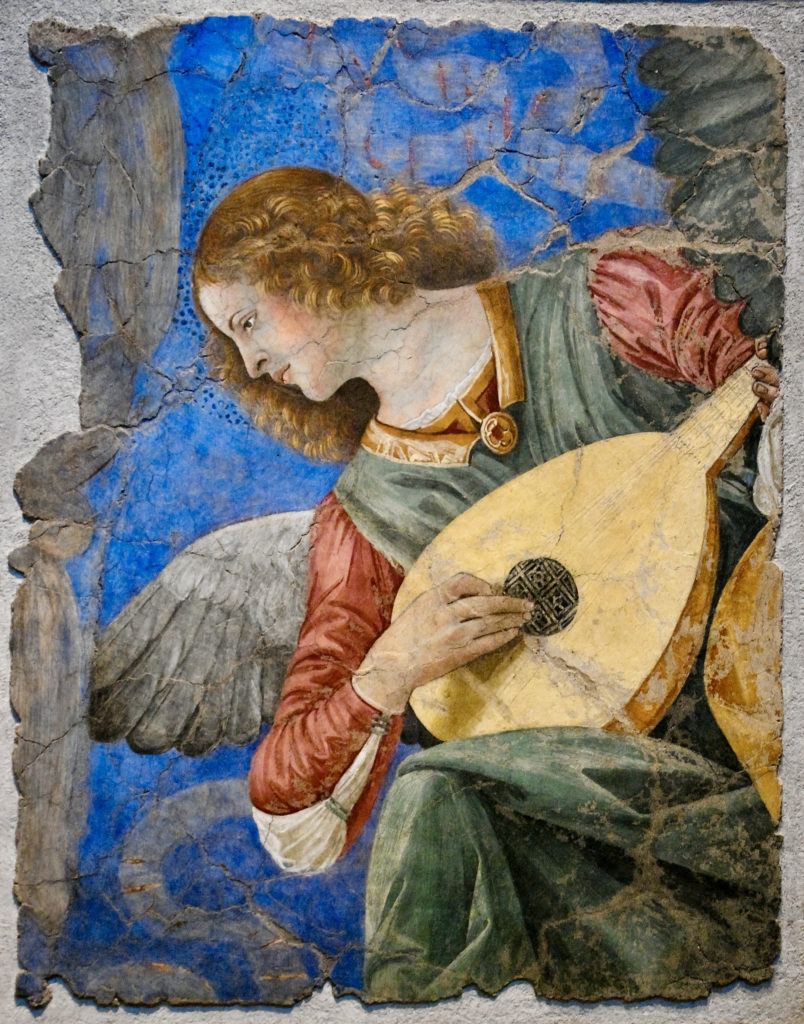
There’s also a strict dress code at the Vatican — no shorts, no hats, no bare shoulders.
Be forewarned, if you’re there in the summer, there’s no air conditioning and it can feel suffocating.
If you’re taking a guided tour, you’ll end at St. Peter’s Basilica. Once inside the basilica, you cannot re-enter the Vatican Museums. So make sure you’ve seen everything you want to see in the museums before venturing in.
And be forewarned. If you’re taking a tour, be sure to be clear on exactly what it covers.
Many Vatican tours skip the Vatican Pinacoteca and the Raphael Rooms. If you’re an art lover, you can’t miss these areas of the Vatican museums.
18. Don’t Skip Bologna
I loved underrated Bologna. Compared to Venice or Florence, it’s crowd free and laid back. It makes a good base for day trips to Parma, Ferrara, Ravenna, Modena, and even Florence or Venice.
But the main reason to stop here is the food. Bologna isn’t nicknamed La Grassa, the Big Fat, for nothing. It’s a true foodie hub. And isn’t that part of the joy of traveling in Italy?
19. Follow the Italian Eating Schedule
You’ll need to get your stomach used to Italian meal times.
Meals times in Italy vary from the US. In Italy, lunch is from noon until 3:00 p m. Dinner is from 7:30 pm to 10:00 pm.
Don’t expect a hearty American style breakfast either. In Italy, breakfast consists of espresso, cappuccino, and a sweet pastry.
20. Seek Out Some Hidden Gems
Italy’s major cities have so many amazing attractions you could spend a lifetime discovering them all. If you have tourist phobia or are a repeat visitor, seek out some hidden gems and off the radar attractions.
Many are just as amazing as the marquee sites, but without the crowds. It’s nice to add at least one off the beaten path attraction to your itinerary.
I’ve written several guides for hidden gems in Rome, hidden gems in Florence, and hidden gems in Italy.
21. A “Bar” in Italy Isn’t a “Bar” in the US
In the US, a bar is where you drink beer and cocktails. In Italy, a bar is where you get coffee. Most Italians stand up to drink their coffee because it’s cheaper than sitting down at a cafe.
One thing to consider is that, for Italians, its verboten to order a cappuccino after 11:00 am. Italians believe that milk is bad for the digestion and so stick with espresso for the rest of the day.
22. How To Order Coffee in Italy
Italy has some of the world’s best coffee and a serious coffee culture.
Here’s a breakdown of the different kinds of coffee you can order, so you don’t make a mistake:
- Espresso: a shot of dark coffee
- Caffe Normal: another name for a shot of espresso
- Caffe Doppio: 2 shots of espresso (mostly for tourists)
- Coffee Americano: basically espresso diluted with lots of water
- Cappuccino: equal parts espresso, steamed milk, and foamed milk
- Caffe Lungo: a “long coffee,” which has more volume and is milder than espresso
- Caffe Corto: the densest for of coffee, even stronger than espresso
- Caffe Latte: coffee served with hot milk and less foam
- Caffe Macchiato: a shot of espresso with a dash of steamed milk
- Latte Macchiato: a shot of milk with a dash of coffee
- Caffe Corretto: spiked coffee, usually with a shot of grappa
Italians don’t drink cappuccino after 11:00 am. But they will be happy to serve you, if that’s you preferred drink.
23. The Italian Happy Hour is the “Apertivo”
Apertivo is the Italian version of happy hour. It’s a ritual of indulging in a pre-dinner cocktail or apertivo and small nibbles of freefood. It’s a luxe version of our happy hours.
Unlike the American happy hour though, the Italian Apertivo may last from 6:00 to 9:00 pm.
For their Apertivo, Italian like traditional cocktails like a Bellini, Negroni, Campari, or Apersol Spritz.
24. Eat the Local Specialty
Italian cuisine varies widely by region. As you plan your trip, learn about what to eat where. Each region is known for specific dishes.
Rome is known for pasta carbonara, Milan for risotto, Bologna for pasta ragu, Naples for pizza. Tuscany for steak.
Don’t ask for things you might eat at home, like a pepperoni pizza.
You’ll need to ask for the check at the end of your meal. In general, Italian meals are a relaxed affair, not to be rushed.
Service isn’t as quick as you’re used to. So the waiters won’t bring the check at the end of your meal unless you ask for it. You can ask for the check by saying “Il conto, por favore.”
For small, popular or Michelin starred restaurants, you’ll need a reservation. This is especially true if they’ve been featured in Tripadvisor or other sites.
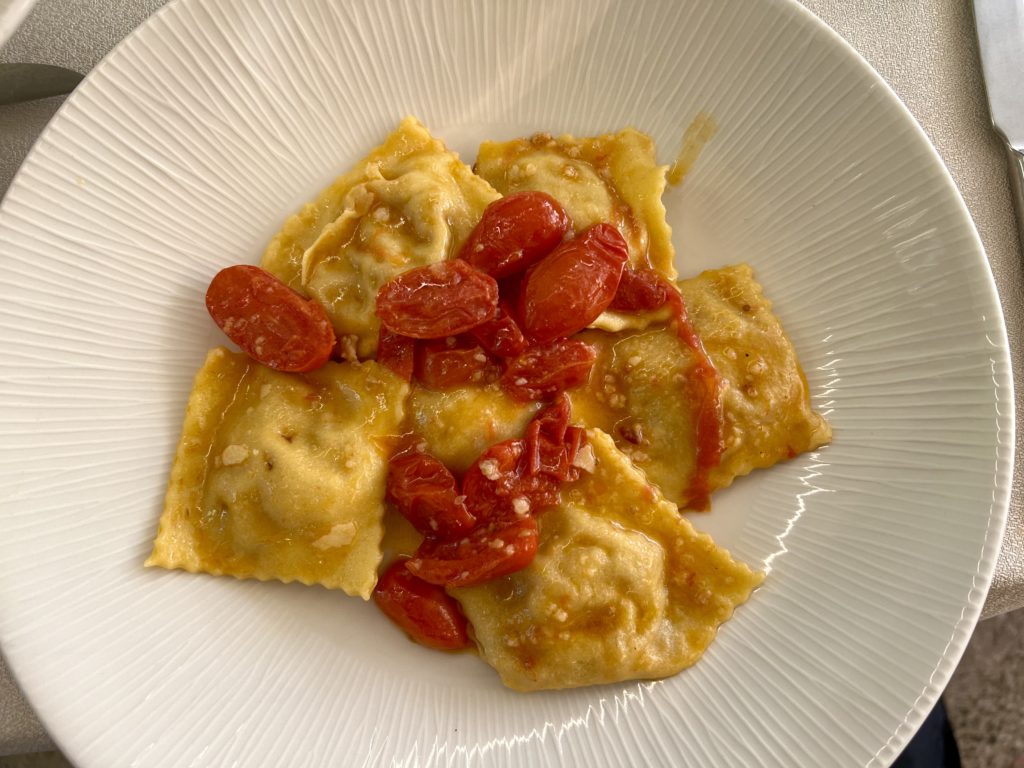
25. Hidden Charges For Meals
Don’t be surprised when you’re given bottled water with your meal.
Italians generally do’t drink tap water. It’s not really a thing. You’ll have to pay for water. You will need to specify whether you want still water (natural) or sparkling water (frizzante).
There’s also often a coperto, which is a cover charge. Don’t be shocked. It’s not a scam.
It’s usually a service charge for the bread served, which is pretty tasty. You’ll be charged even if you didn’t order bread. It’ll be listed as pane on your bill.
26. Don’t Eat Near Popular Tourist Sites
Not every restaurant in Italy is a food haven or life changing experience. This is a utopian fantasy. You should do your research, not just walk into any random restaurant.
Since Italy is a tourist magnate, there are scads of lower quality restaurants catering to fast moving tourists, especially in touristy areas in Rome, Florence, and Venice.
A restaurant is likely a tourist trap if:
- there’s a host outside trying to lure in guests
- if you see a lot of tourists eating there
- if an English menu is posted outside
- if they offer omelettes
You’ll have more luck with a tucked away off the beaten path family-owned restaurant filled with locals. If you haven’t made a reservation, follow the Italians.
27. Drink the Local Specialty
As with food, you should drink the local wine. The wine varies by region, and generally the local wine pairs well with the local food. Click here to see an Italian wine map by Wine Folly.
As a general rule, drink red wine when eating meat, cheeses, or hearty pastas. Drink white wine with seafood on the coast. The “house” wine is often an affordable tasty option.
28. Buying Groceries
If you’re staying in your own place, you’ll need to shop for groceries. In Italy, grocery stores are called Conads.
Conads aren’t usually found in the center of historic towns but rather on the outskirts of the town or city.
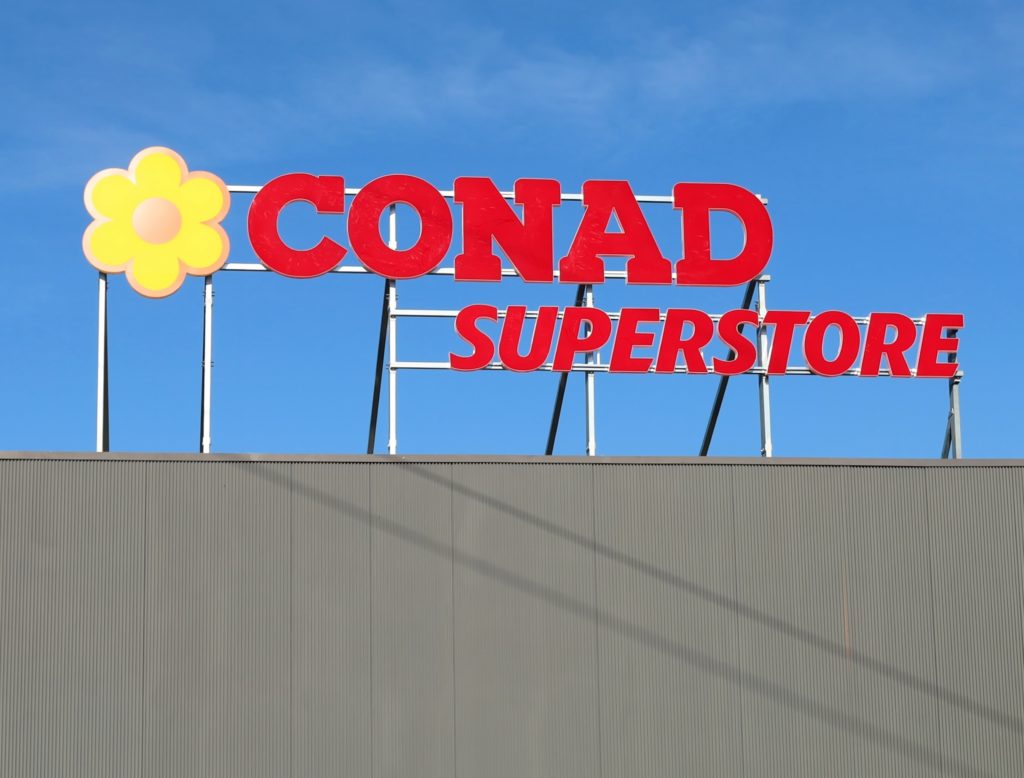
You’ll typically need to either bring your own bags to bag the groceries or purchase then at the conad.
29. You Don’t Need To Tip … Much
You don’t need to tip in Italy, unlike the US. The waiters make a good living wage. However, it is customary to round up if you’ve had good service with a few euros.
30. The Midday Break called Riposo
Shops are often closed during the lunch and dinner hours, so that the owners can enjoy the midday Italian riposo, or siesta. Don’t plan your shopping for that time.
31. Dress Appropriately For Church Sightseeing
Italy’s churches, basilicas, and cathedrals are among the top attractions to see in Italy. Not only are the marbled facades dazzling, but the interiors are also incredible.
Many of them were decorated by the most famous artists of the time, including by Botticelli, Leonardo, Caravaggio, Bernini, and Michelangelo.
But if you want to see the art inside, you have to follow the dress code. For women, that means no showing of shoulders or legs above the knee.
For men, it generally means no shorts much above the knee. Generally, short shorts or mini skirts are a no no.
The codes aren’t always enforced. And it’s possible that the church will hand you a large piece of cloth to wrap around your bare legs. But they may just as easily turn you away if you’re not dressed to code.
Here’s my guide to the most beautiful churches in Italy.
32. Restrooms are Scarce in Italy
Public restrooms in Italy, like much of Europe, are scarce commodities. If they do exist, you’ll likely have to pay a euro to use them.
To combat this problem, you have three methods: (1) stop in at a bar for a quick espresso so you can use the facilities (you can’t just walk into a bar); (2) plan your day to include a museum or major attraction that has facilities for its customers; or (3) be on the lookout for a McDonalds.
Sometimes the restrooms are unlocked. Sometimes you have to pay to use them.
33. Bring a Water Bottle
Bring a water bottle with you for your day of sightseeing. In Italy, you can often refill your water bottle for free at the many public fountains. Just make sure it doesn’t say “non-potable.”
34. Buy Skip the Line Tickets for Major Attractions
This tip for Italy is so important!!! Don’t waste your precious time in Italy standing in long lines for hours.
Pre-book skip the line tickets for the popular attractions, especially in Rome, Florence, and Venice where many attractions will be sold out.
In Rome, you can buy a trifecta pass for the big three — the Colosseum, the Roman Forum, and Palatine Hill. You’ll also need to make a separate timed entry reservation for the Colosseum.
Here are some tour options you can choose from. They all vary slightly in duration and what you see.
So pick one that best suits your sightseeing agenda. I’ve done the fourth and seventh one on the list and loved the tours.
- skip the line entry tickets to all 3 sites
- tickets + a 2 hour guided tour for all 3 sites
- 3 hour guided tour and entry to all 3 sites
- tickets & tour of all 3 sites + underground Colosseum access
- Colosseum tour with entry tickets for Palatine Hill and the Roman Forum
- skip the line private guided tour with an art historian
Many of the newest archaeological sites in Rome can only be accessed with a special pass, called the S.U.P.E.R. Pass. Here’s my guide to S.U.P.E.R. pass and what sites it covers.
In Florence, you’ll also need skip the line passes for popular attractions such as the Vatican Museums and the Borghese Gallery in Rome, the Uffizi Gallery and the Duomo complex.
In Venice, you’ll need to pre-book tickets for St. Mark’s Basilica and the Doge’s Palace.
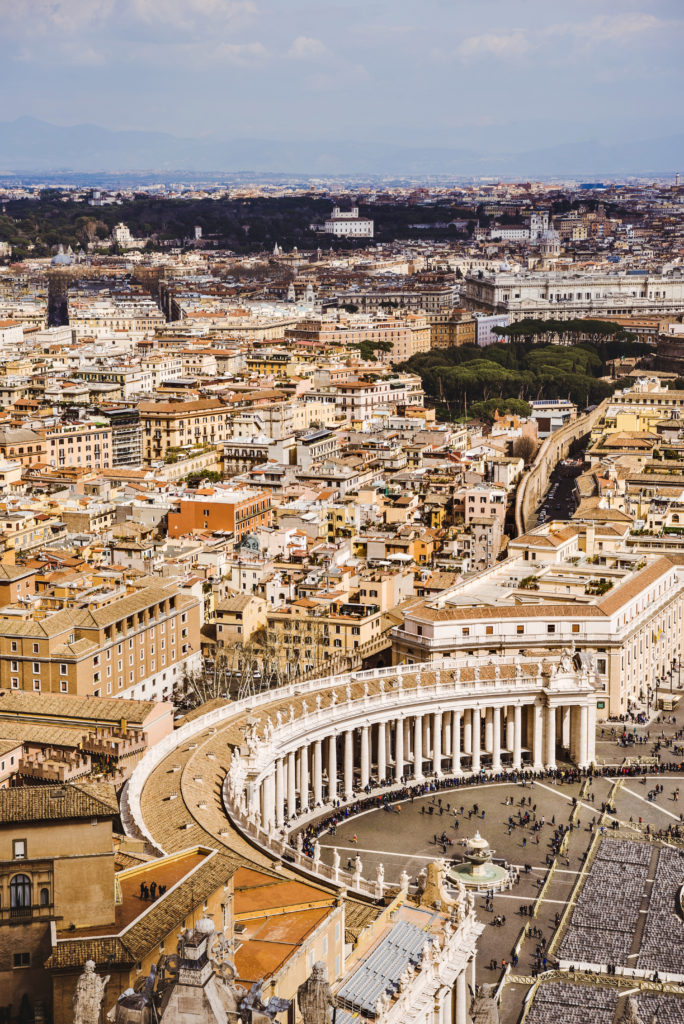
If you click on the links to my guides, you’ll find everything you need to know abut tickets and tours for these attractions.
You’ll also need advance reservations in Florence for seven must see attractions in Florence.
35. Hold On To Your Ticket
Once you’ve got your ticket, hold onto it and don’t discard it. In Italy, museums may check your ticket at 2 or 3 different access points.
And some museums are not just one museum, but several different ones in the same building.
36. Book Accommodations Outside the Noisy Central Areas
Most guides advise you to stay in a central area. I’m not sure about that. If you don’t mind walking you can stay in a cute neighborhood, save money, and avoid noise.
Italian cities can be lively, with people staying up well into the wee hours. This is great when you’re out having fun.
But, if you’re a light sleeper like me, you may want to stay off center to keep the noise out of your bedroom when the sandman comes.
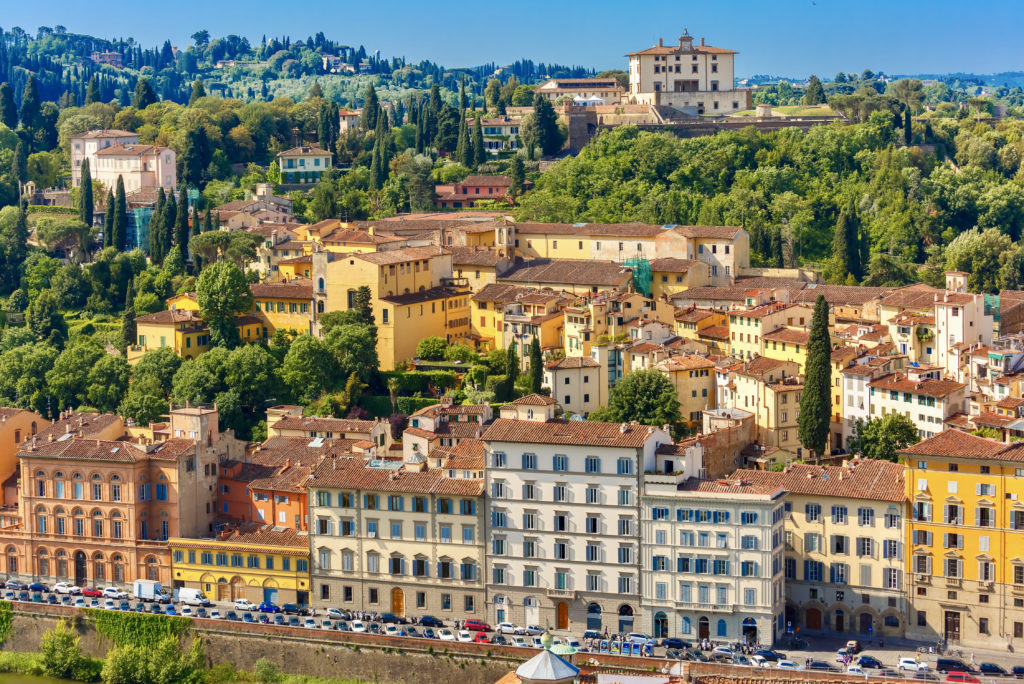
It’s easier to stay away from the hotspots. Usually, you’re never too far from them anyway.
For example, last time I was in Rome, I stayed in an Air Bnb in the Trastevere neighborhood across the Arno and away from centro historico.
37. It Helps To Be an Early Riser
Most Italian cities reward early risers, from gorgeous sunrises to empty streets for frolicking in peace.
If you save all your sightseeing for early to mid afternoon, that’s a sure fire recipe for crowds. Especially if you haven’t pre-purchased skip the line tickets.
If you’re not an early riser, aim for late afternoon to visit the major attractions.
38. Do Some DIY Prep Before You Go
Don’t just show up in Italy. Italy spans the ancient Roman to Renaissance periods.
You can read my guide to all the Roman emperors or my nutshell history of Ancient Rome.
Italy will be much more rewarding if you’ve done some background research and DIY prep,. Buy a guide book, listen to podcasts, or watch some Youtube videos.
Smarthistory has wonderful videos on art and architecture throughout Italy. Rick Steve’s has YouTube videos on Italy. My favorite podcast on the Renaissance is called Rebuilding the Renaissance, which makes art come to life.
39. Artist Trails
If you’re a fan of Renaissance and Baroque art, Italy has the world’s best masterpieces of art and architecture.
If you have a particular artist you love, I’ve written guides to various artist trails you can follow in Italy:
- Michelangelo Trail in Florence
- Leonardo da Vinci Trail in Milan
- Piero della Francesco Trail in Italy
- Andrea del Verrocchio’s Art in Florence
- Caravaggio Trail in Rome
- Bernini Trail in Rome
- Leonardo da Vinci’s Paintings
- Botticelli Trail in Florence
- Artemisia Gentileschi Paintings
READ: How To See Leonardo’s The Last Supper in Milan
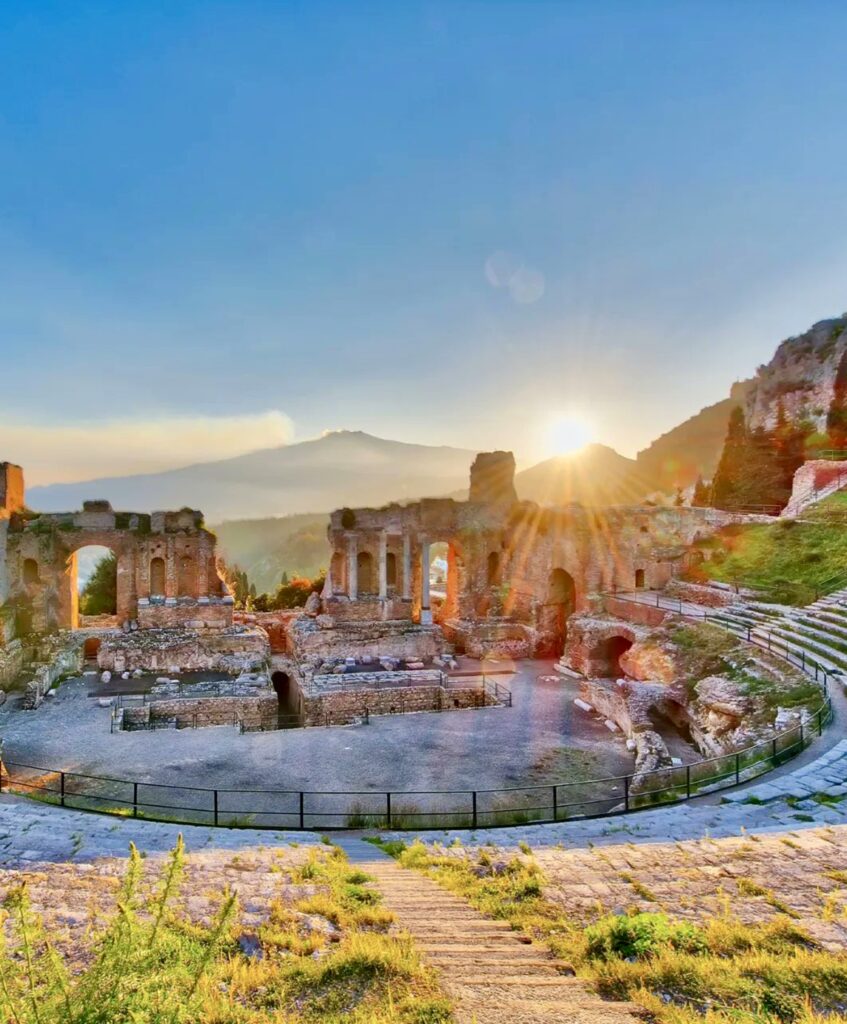
40. How To Tackle Sicily
Thinking of heading to Sicily? The island has a distinct history and culture that set it apart from the rest of Italy.
The island has been governed by an impressive array of civilizations. This unique heritage left behind a treasure trove of stunning Greek temples, Roman villas, and mosaic-adorned cathedrals.
In addition to its ancient wonders, Sicily also offers a plethora of culinary delights. Its cuisine is some of the freshest and most flavorful in all of Italy, and the street markets are an experience in themselves.
But Sicily is huge! You can’t visit it on a weekend or even a week. Unless you’re a return visitor focusing on a certain region, I think you need 10 days or 2 weeks to explore Sicily properly.
I hope you’ve enjoyed my guide to must know tips for visiting Italy. If you need more Italy reading, here are some of my other Italy travel guides and resources:
- 30 Beautiful Towns in Italy
- Guide To the Best Art in Ital
- Day Trips From Florence
- Must See Sites in Venice
- Best Museums in Italy
- Best Museums in Rome
- Best Museums in Florence
- Historic Landmarks in Italy
- Guide to the Mosaics of Ravenna
- Guide to the Medici Palaces
If you want tips for visiting Italy, pin it for later.

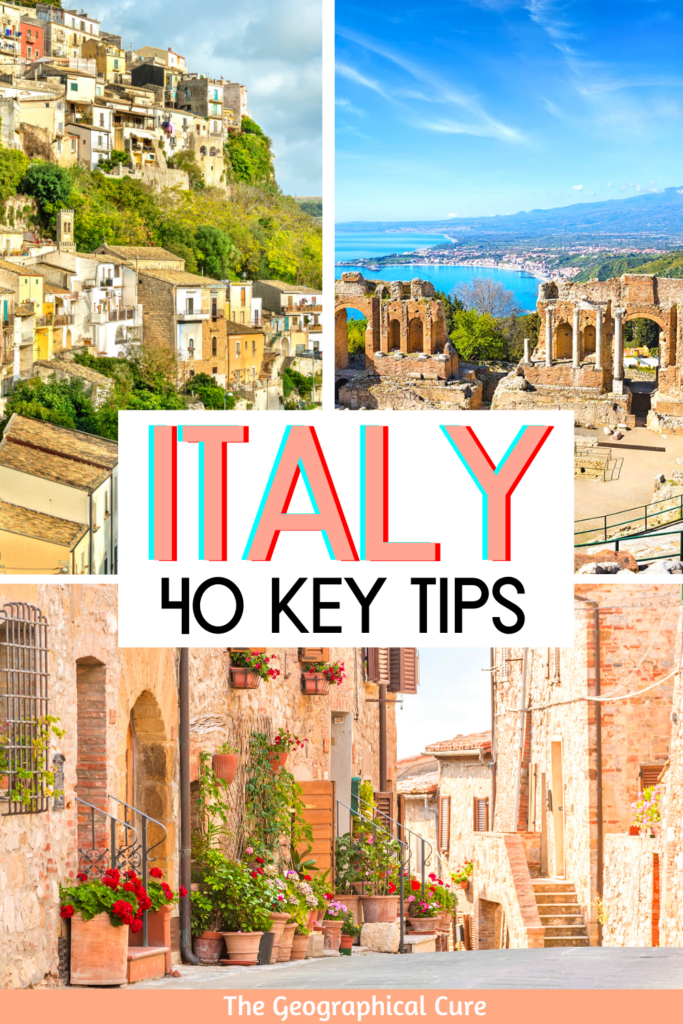
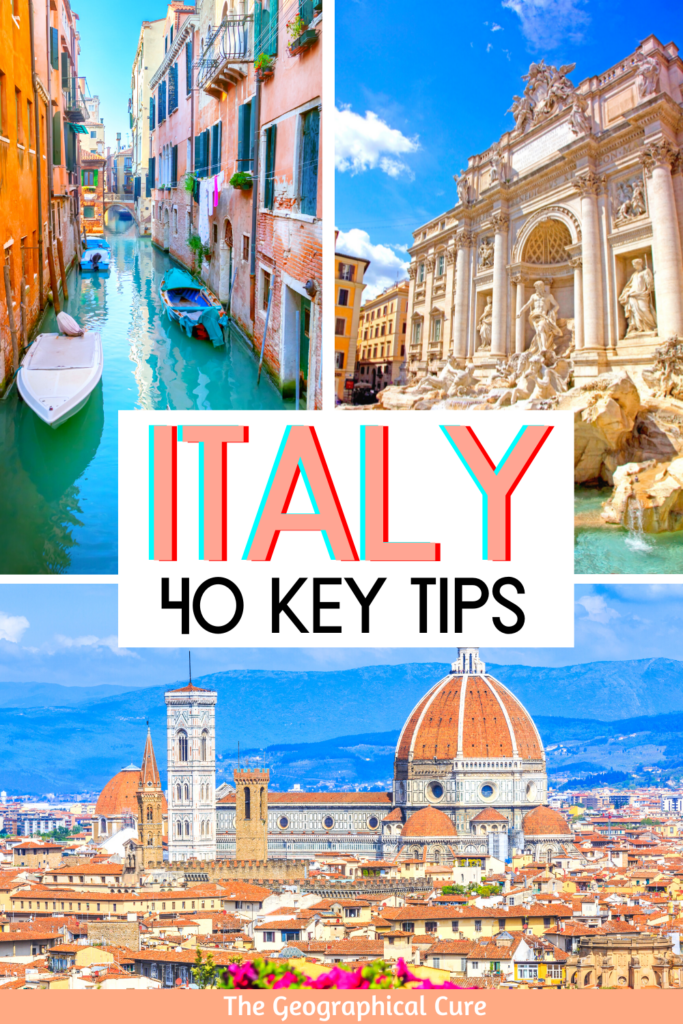
This is all very helpful. I haven’t been to Italy (only Rome) in >10 years and my husband and I are returning this summer. We’ll be flying separately and I plan to take a private transfer from Fiumicino Airport to our hotel. I see this is your preference, too. Do you have a preferred provider for this? Many thanks!
No, I don’t have a provider. My travel agent actually booked my flight and the transfer. But you can also book a transfer on Viator or Get Your Guide.